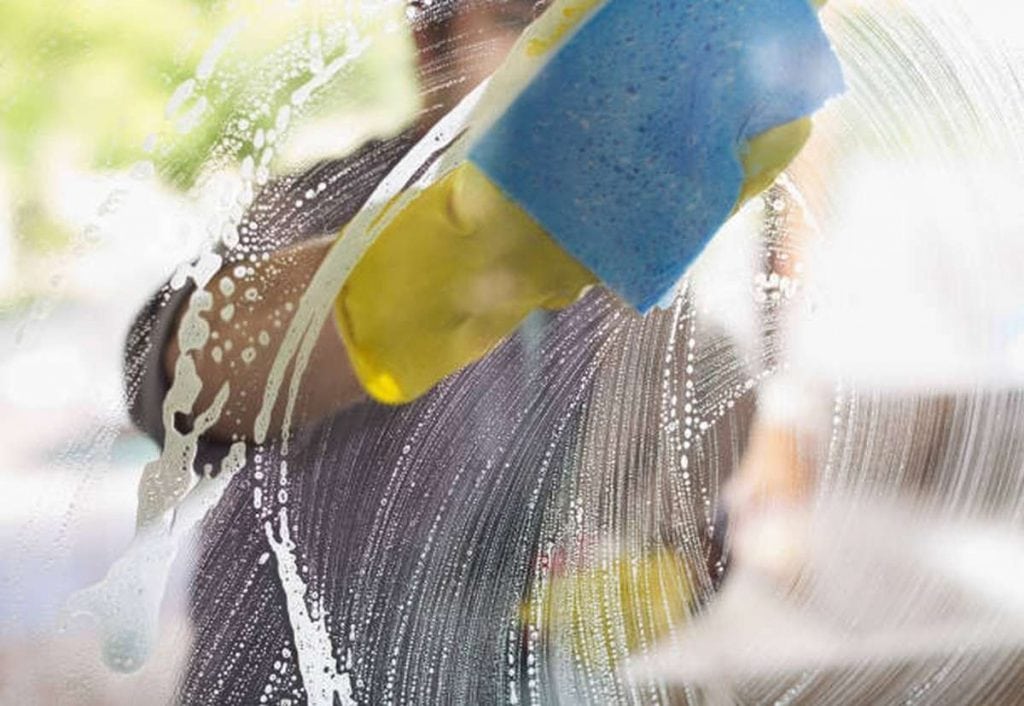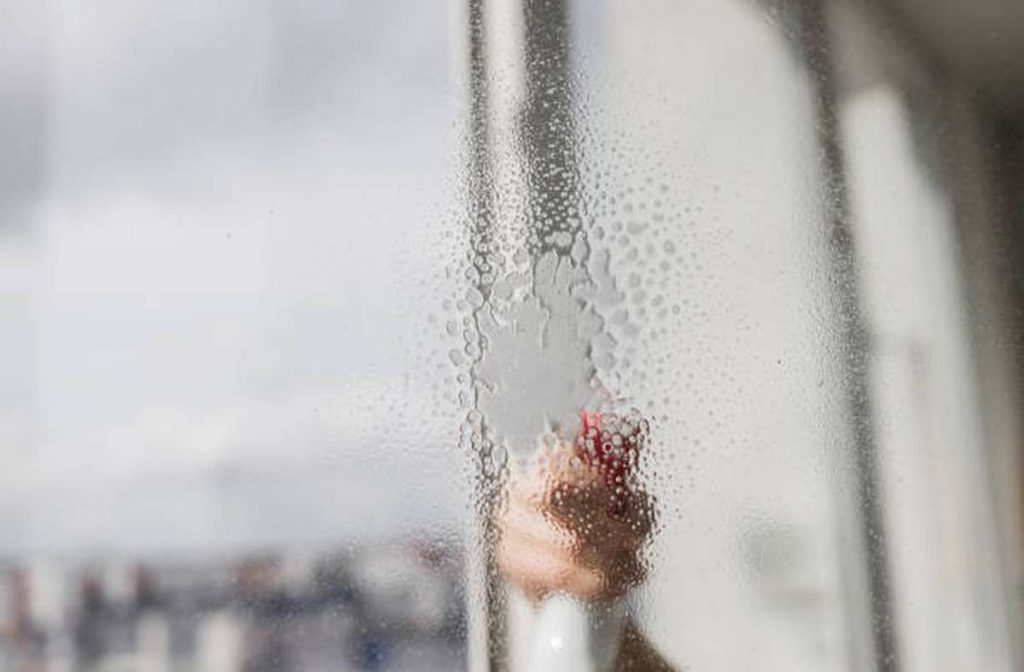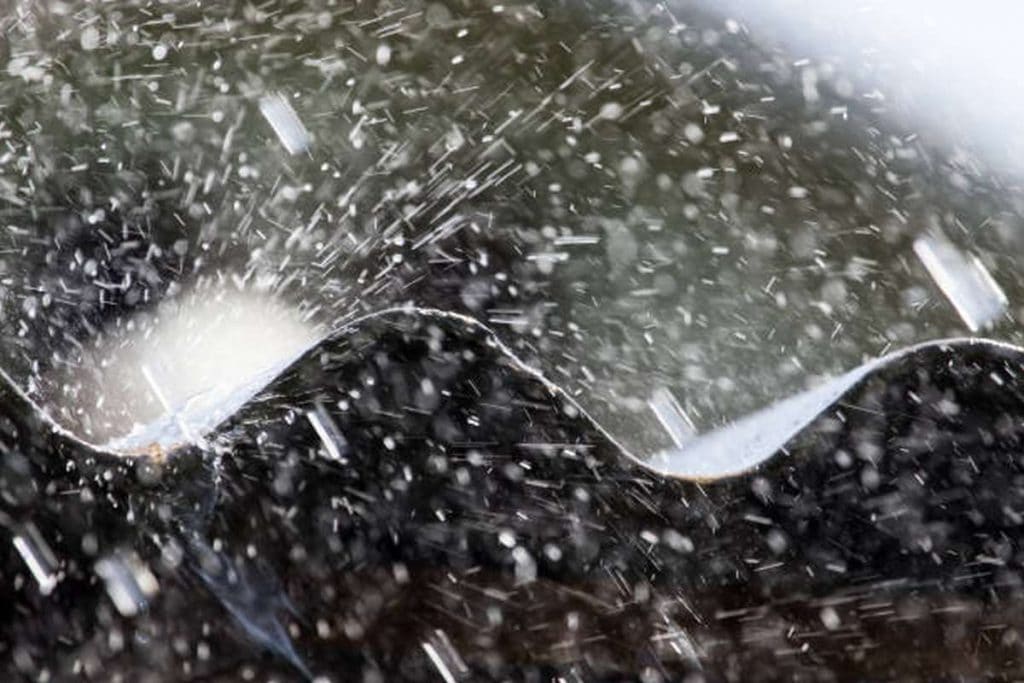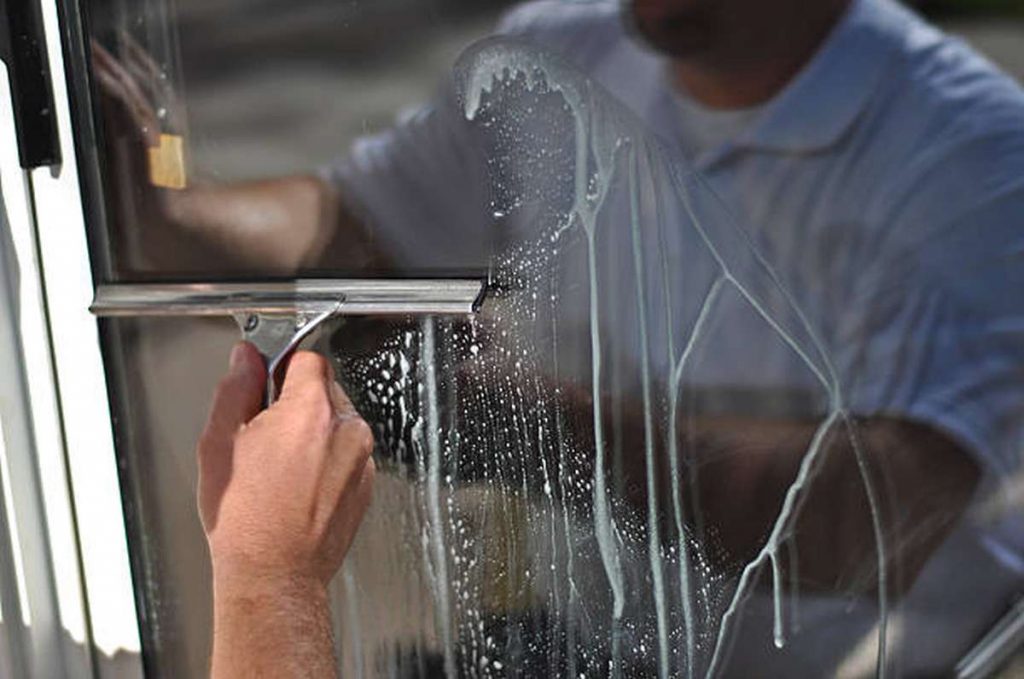Cleaning your exterior windows can be challenging if you don't know the right methods, products, and tools to use. Not only is dust and dirt build-up an eyesore, but it can also inhibit the amount of natural light entering your home, detracting from its overall appearance. Luckily for you, this blog post will provide comprehensive instructions on how to clean your exterior windows—from selecting the best cleaning supplies to applying them effectively – so that you get the most sparkling results! So read on for all our top tips on achieving streak-free windows without hassle.
Use a Garden Hose

Cleaning windows with a garden hose and an adjustable nozzle adapter is a tried and reliable method used by the pros. You can clean your windows with a high-pressure stream of water, and you won't have to worry about missing any crevices.
First, spray the window and surrounding area to loosen and remove any loose dirt. The next step is to combine dish soap with hot water in a bucket. Next, use a cloth or rag to apply the solution and scrub the mixture onto the exterior windows. Next, use your garden hose to remove the soapy water and let it dry up a little bit. Then, spray the windows with a commercial windows cleaning agent or a mixture of vinegar and water. Finally, use a microfiber cloth to remove the solution and reveal a pristine surface.
Opt for a Household Mop
Cleaning windows within arm's reach with a garden hose or sponge is an efficient method, but for those out of reach, an extension pole made from a household mop can be used to gain the extra leverage necessary to scrub away dirt and grime.
Window cleaning accessories for mops are readily available. Wrapping your mop in a sticky gunk microfiber towel is a good idea if you're not using an attachment to keep small particles from damaging the glass while you clean. Then, use your mop and some homemade window cleaner to get the exterior windows completely streak-free.
Try a Streak-Free Squeegee
For streak-free results, use rubber-bladed scraper equipment to wipe off outside glass. First, create a cleaning liquid of your choosing, then use a rag, cloth, or mop to scrub the glass.
To get the most out of your squeegee, use this method:
- With the squeegee's tip, begin at the top corner of the glass and clean a thin strip along the edge of the window.
- Start at the top of the window and put little pressure on the squeegee's edge. Use a horizontal motion at a downward angle to move the squeegee across the window.
- Always have a dry or paper towel on your hand to clean the squeegee's blade after each stroke.
- To avoid leaving streaks, repeat the process from the top down, carefully overlapping the areas you've already wiped.
- Use a dry, lint-free cloth to remove any puddles of water if you find any.
Consider a Magnetic Cleaner
Choose a magnetic cleaner to clean your windows without risking injury from climbing a ladder if you live in a high-rise flat or are otherwise inaccessible. This magnetised tool cleans a window's interior and exterior with minimal effort. First, however, here are some general measures to take (the specifics may vary by brand).
- Make a cleaning solution by combining equal amounts of vinegar and water with a few teaspoons of liquid dishwashing to create a foamy solution.
- Soapy water can be used to clean the two sponge halves of the instrument by soaking them in the solution and then rubbing them together.
- If your tool has a safety cord, tie it to a secure indoor location (such as the window crank) in case the magnet detaches.
- Simply open the window, align the tool's outer half with the inner half, and then close the window to keep the magnet in place.
- When cleaning windows, use the sponge side and move gently and carefully in a horizontal movement to ensure the magnet remains attached.
- After that, use the squeegee side to go back over the same area but this time in the opposite direction.
- Some designs include a microfiber towel that may be wrapped around the parts to remove moisture.
Use A Squeegee
If you need a ladder to reach your window, put your well-being first. One way to clean glass windows from the outside is with a window squeegee. In addition, a window squeegee with an extension can be stretched to several metres. In addition, you may clean upper windows without having to use a ladder.
Raise yourself to a comfortable working height for cleaning the windows. Modern microfibre is used in a window squeegee. The squeegee is also of great quality. First, moisten the pad to remove grime from the wall. Afterwards, use a broad, smooth rubber brush to wipe down the side windows.
Dry With Newspaper
Microfiber towels or squeegee are ideal for removing residue, but you can also use a newspaper in a pinch. It's simple: Get rid of the grime and debris with whatever cleaning strategy you want. Then, use crumpled-up newspaper rubbed circularly on the glass to remove any leftover dirt.
The newspaper ink won't leave a stain on the glass but will leave a mark on the sills. Put painter's tape over the sills to protect them while you dry the windows.
Break Out the Power Washer
A power washer is one of the most efficient and effective cleanings of outside windows. Before you apply any pressure, you should check the condition of the windows, trim, or siding to be sure nothing will be harmed. Then, check for any cracks or holes in the caulking around your windows and fix them if required. The power of the water could further tear paint already flaking off the windowsill.
Choose a detergent or concentration compatible with your power washer and designated for use on windows (this information can be found in the manual). Then, place the cleaning solution in the power washer's reservoir, spray the windows and trim with an upward angle using the wand.
Finally, turn up the pressure on your nozzle and give the windows a final rinsing. Then, direct the wand downward so the water can escape through the bottom. When you're done washing the windows, and the soap is gone, dry them thoroughly with a microfiber cloth for a streak-free result.
Purchase a Window-Cleaning Kit
Instead of buying individual items to clean your windows, consider picking up a washing kit from your neighbourhood hardware shop. Most sets include an extension pole-compatible squeegee and a scrubbing brush.
Some of them may even have optional add-ons and a lengthy pole so that you can tailor your work to your exact specifications. After that, use the scrubber to apply your preferred cleaning solution, and finally, use the squeegee to dry the surface and reveal its gleaming new sheen.
Invest In a Robotic Cleaner
Stop wasting your time cleaning your windows by hand and use a robotic cleaner instead. Numerous variations exist, but all these gadgets adhere to the glass with strong suction and wipe it down with a microfiber pad, either reusable or disposable. Afterwards, secure the gadget outside the window and attach the safety harness to the room. The automated cleaner will scan the area and plot a course to clean the glass at your command. A common price range for this window cleaning service is $300 to $600.
Don't Forget Your Window Screens
Don't waste your time cleaning the windows if you don't also clean the screens. To keep your clean windows free of screen dust and grime, you should do this before washing the glass. Get started by taking out the screens and laying them out flat.
Using a brush vacuum connection is recommended to remove as much dust as feasible from screens before washing them with soap and water. This will ensure that no dust particles remain on the screen after cleaning. Then, use a hose to wash away what debris remains after vacuuming it.
Then, mix half a gallon of warm water with a quarter cup of dish soap, another all-cleanser, white vinegar, and the rest of the cleaning supplies. Use a sponge and this solution to scrub the screens free of dirt, then rinse with a hose to remove the cleaner and any residue. The screens should be left to dry for a full day before reinstalling.
Clean the Window Sills

Do not squander the chance to clean the window sills once you have finished washing the windows and putting the screens back in place. Instead of focusing here on sills and window tracks, use the brush vacuum adapter to help remove the trash and spiderwebs.
To remove mould or grime:
- Spray an all-purpose cleanser over the affected area and let it sit for a while.
- Apply some dish soap to a tooth and wet it with hot water to reactivate the soap (have a basin of warm water handy, as you will need to repeat this step multiple times).
- Brush the dirt away with the toothbrush and wipe it away with the microfiber towel.
Cleaning the Inside of the Windows
- Fill a large pot or bucket with clean, lukewarm water and a few sprays of liquid dish soap.
- To prevent any messes from getting through the window, place a huge bath towel there.
- Start at the top and work down the window with a damp microfiber cloth or sponge. The outside and inside of the frame should also be cleaned.
- You can use a vinegar-water mixture or a professional window cleaner to spray the glass well. Additionally, you can combine one ammonia capful with two litres of water.
- To thoroughly dry the window, use a clean, sticky gunk towel and a Z-shaped motion. You can use clean rags or paper towels to dry your windows.
- Spray it down again and let it dry if there is still dirt or streaking. (Cleaning grimy window panes usually necessitates a couple of sprayings and dryings.)
- You should work on an overcast, chilly day to ensure the dishwashing water and display solutions do not dry on the windows.
Conclusion
The professionals utilise a tried and true method for cleaning windows: a garden hose fitted with an adjustable nozzle. Use rubber-bladed scraper equipment to clean exterior glass without leaving streaks. If you're not using an attachment, protecting your mop with a sticky muck microfiber towel is an excellent idea. If you don't have access to a ladder, live in a high-rise building, or are otherwise unable to clean your windows manually, you may want to invest in a squeegee or magnetic cleaner. Cleaning glass windows from the outside can be done in several ways, including with a window squeegee and an extension that can reach several metres.
When it comes to cleaning the exterior of your windows, a power washer is one of the most time and labour-saving options. Get a window washing kit from your local hardware store rather than buy all the separate components separately. Don't waste time scrubbing windows by hand when you can employ a robot to perform the job instead.
Content Summary
- Exterior window cleaning can be difficult if you don't have the necessary knowledge, supplies, and equipment.
- Dust and filth accumulation is not only unsightly, but it can also block natural light from entering your home, diminishing its overall beauty.
- So that you may obtain the most gleaming results from washing the windows on your home's exterior, this guide will walk you through every step, from choosing the right cleaning products to using them properly.
- Keep reading for our tried-and-true methods for effortlessly achieving spotless window surfaces.
- Water the garden using a hose.
- The professionals utilise a tried and true method for cleaning windows: a garden hose fitted with an adjustable nozzle.
- With a high-pressure water spray, you can clean your windows thoroughly without missing any nooks or crannies.
- Start by spraying the window and the surrounding area to loosen any dirt.
- The following step is to fill a bucket with hot water and add dish soap.
- Then, add the solution to a cloth and scrub the external windows with the rag.
- Then, spray off the soapy water with a garden hose and let it air dry for a while.
- The next step is to use a commercial window cleaner or a vinegar and water solution to spray the glass surfaces.
- Then, wipe away the solution with a microfiber towel to reveal a spotless finish.
- To efficiently clean windows that are out of reach, an extension pole constructed from a household mop can be used to achieve the necessary leverage to scrub away dirt and grime.
- Mop attachments designed specifically for cleaning windows are easily accessible.
- If you're not using an attachment to avoid dust and dirt from scratching the glass as you clean, wrapping your mop with a sticky muck microfiber towel is a fantastic option.
- The external windows can be cleaned of all streaks using a mop and some homemade window cleaner.
- Use rubber-bladed scraper equipment to clean exterior glass without leaving streaks.
- Put very light pressure on the squeegee's edge and begin at the top of the window.
- You should move the squeegee across the window horizontally at a downward angle.
- After each stroke, wipe the squeegee's blade clean with a dry towel or a roll of paper towels.
- Wipe from the top down again, gently overlapping the areas you've already wiped to avoid leaving streaks.
- Any pools of water should be wiped up with a dry, lint-free cloth.
- If you don't want to risk harm by climbing a ladder to clean your windows because you live in a high-rise apartment or any other inaccessible location, consider purchasing a magnetic cleaner.
- This magnetised tool efficiently cleans both the inside and outside of a window.
- But first, here are some broad guidelines to follow: (the specifics may vary by brand).
- A cleaning solution can be made by mixing equal parts vinegar and water with a few teaspoons of liquid dishwashing detergent to form a frothy solution.
- The two sponge halves of the instrument can be cleaned by immersing them in soapy water and then rubbing them together.
- Use the tool's safety rope to fasten it to anything stable inside (like a window crank) in case the magnet comes loose.
- To use, open the window, line up the tool's outer half with the inner half, and then shut the glass to secure the magnet.
- Use the sponge side and slide slowly and softly in a horizontal motion to keep the magnet connected while cleaning windows.
- Then, going again over the same ground in the other way, this time with the squeegee side is recommended.
- You can dry the components by wrapping them in a microfiber towel, which is included in some designs.
- Consider your safety first if you need a ladder to reach your window.
- A window squeegee can be used to clean glass windows from the outside.
- Moreover, a window squeegee with an extension can be lengthened to several metres.
- Remove residue with a microfiber towel, squeegee, or even a newspaper if necessary.
- It's elementary: Use your preferred cleaning method to remove dirt and dust.
- Then, massage the glass in a circular motion with a crumpled-up newspaper to eliminate any remaining dirt.
- Even if the newspaper ink doesn't damage the glass, it will leave a mark on the sills.
- While the windows dry, protect the sills by taping them off using painter's tape.
- When it comes to cleaning the exterior of your windows, a power washer is one of the most time and labour-saving options.
- If the windows, trim, or siding are in good shape, then you can apply pressure without worrying about damaging anything.
- The caulking surrounding your windows should be inspected for damage, and if necessary, repaired.
- Already flaking paint on the windowsill may be torn off entirely by the force of the water.
- The best way to clean your windows with a power washer is to use a detergent or concentrate that is specifically designed for that purpose (this information can be found in the manual).
- Then fill the power washer's solution tank and spray the windows and moulding at an upward angle.
- Finally, give the windows a final rinse with the pressure turned up on your nozzle.
- Next, point the wand down so the water may drain out the bottom.
- After washing the windows and rinsing off the soap, dry them completely with a microfiber cloth to remove any traces of water.
- Get a window washing kit from your local hardware store rather than buy all the separate components separately.
- Scrubbing brushes and extension pole-compatible squeegees are standard inclusions in cleaning tool kits.
- You may be able to customise your job to your particular needs with the help of some of them, since they may come with extra accessories and a long pole.
- Then, apply your cleaning solution using the scrubber, then use the squeegee to dry the surface and reveal its brand-new lustre.
- On instruction, the robot cleaner will assess its surroundings, and then follow its own carefully plotted path to wipe down the glass.
- Typically, you should expect to pay between $300 and $600 for such professional window cleaning.
- Do not bother cleaning the windows unless you also plan to clean the screens.
- If you want your clean windows to stay clean and free of screen dust and dirt, you should do this first.
- Take out the screens and lay them down flat as a first step.
- Before washing screens with soap and water, it is best to remove as much dust as possible using a brush vacuum attachment.
- With this method, the screen can be cleaned thoroughly and not have any dust particles left afterwards.
- After vacuuming, the area should be washed down with a hose to remove any lingering particles.
- Then, combine a quarter cup of dish soap, another all-purpose cleaner, white vinegar, and the remaining cleaning products in half a gallon of warm water.
- Scrub the screens clean using a sponge dipped in this solution, and then flush them with water from the hose to eliminate the cleaner and any residue.
- Screens need a full day to dry before being reinstalled.
- After washing the windows and replacing the screens, don't forget to give the sills a good cleaning as well.
- Use the brush vacuum adapter to help eliminate the garbage and spiderwebs in this area rather than focusing on the sills and window tracks.
- Spraying an all-purpose cleaner over a dirty area and letting it sit is an easy way to eliminate mould or filth.
- When you put some dish soap on a tooth and then wet it with hot water, the soap becomes active again (have a basin of warm water handy, as you will need to repeat this step multiple times).
- Use the toothbrush to loosen the grime, and the microfiber towel to scrub it clean.
- Put some liquid dish soap into a large pot or bucket of clean, warm water.
- Put a large bath towel over the window to catch any spills that may otherwise come in.
- Wet a microfiber cloth or sponge and begin cleaning the window at the top and working your way down.
- Clean both the exterior and interior of the frame.
- The glass can be sprayed down with either vinegar and water solution or a commercial window cleaner.
- One capful of ammonia diluted in two litres of water is also effective.
- Use a clean sticky gunk towel and a Z-shaped motion to dry the window completely.
- To dry your windows, use either clean rags or paper towels.
- If there is still dirt or streaks, spray it down again and let it dry. (Generally speaking, dirty windows require multiple sprayings with cleaning solution and dryings.)
- To prevent the dishwater and display solutions from drying on the windows, it is best to work on a cloudy, cool day.
FAQs About Window Cleaning
Immediately after you've sprayed your window with the cleaning solution, wipe it off from side to side using crumpled newspaper or a clean microfiber cloth. Work quickly to avoid streaks. If using a squeegee, wipe the squeegee over the window at an angle, from top to bottom.
Window cleaners purify their water by passing it through a series of filters and resins, making use of natural processes like reverse osmosis and deionisation. They then store this water, usually in a suitably equipped vehicle, so that they can get it to their customers.
It's fine to use a commercial window cleaning spray, but you can also make your own that's just as effective—and much cheaper. Combine about 8 ounces of hot water with a drop or two of Dawn dish soap—which is great for cutting grease and grime, says Fisk—in a spray bottle.
You can also make an all-natural window cleaning solution using a mixture of equal parts white vinegar and hot water. Adding a touch of liquid soap to the vinegar solution will help remove any streak-causing wax left on the window from commercial cleaners used in the past.
In many cases, windows can be installed at least partially from the outside. However, every home is unique, and there may be some features of your home's window openings that require all or part of the replacement window installation process to occur inside.








